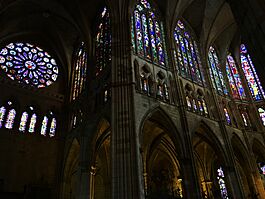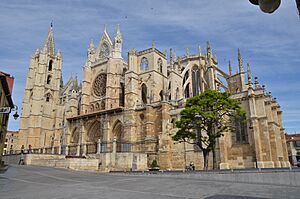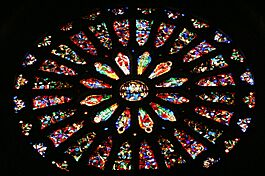León Cathedral facts for kids
Quick facts for kids León Cathedral |
|
|---|---|
 |
|
| 42°35′58″N 5°34′0″W / 42.59944°N 5.56667°W | |
| Country | Spain |
| Denomination | Roman Catholic |
| Website | www.catedraldeleon.org/ |
| History | |
| Status | Cathedral |
| Dedication | Virgin Mary |
| Consecrated | 13th century |
| Architecture | |
| Style | Gothic Architecture |
| Specifications | |
| Length | 90 m |
| Width | 29 m |
| Height | 30 m |
| Number of spires | 2 |
| Administration | |
| Diocese | León |
| Province | León |
The Santa María de Regla de León Cathedral is a famous Catholic church in the city of León, in northern Spain. It is dedicated to the Virgin Mary and was the first building in Spain to be protected as a national monument in 1844.
Construction on this amazing church began in the 13th century. It is a masterpiece of the Gothic style, which was popular in France at the time. Because of its beauty, it is nicknamed the Pulchra Leonina, which is Latin for ‘The Beautiful Leonese’. The cathedral is also a major landmark on the Camino de Santiago, a famous pilgrimage route.
León Cathedral is best known for its incredible stained glass windows. The builders wanted to replace as much of the stone walls as possible with colorful glass. This technique is sometimes called the "dematerialization" of Gothic art, because it makes the heavy stone walls seem to disappear. The cathedral has one of the world's largest and most complete collections of medieval stained glass.
Contents
A Cathedral of Light
The most famous feature of León Cathedral is its huge collection of stained glass windows. There are about 125 windows, covering an area of 1,800 square meters. That's almost the size of five basketball courts!
Most of these windows were made between the 13th and 15th centuries, which makes them very rare and special. Unlike many other old churches, León Cathedral has kept most of its original medieval glass. When the sun shines through, the inside of the church is filled with amazing colors and light.
The design of the cathedral is what makes all this glass possible. Gothic architects used pointed arches and special supports called flying buttresses on the outside. These structures hold up the weight of the roof, so the walls don't have to be thick and solid. Instead, the walls could be opened up to create giant windows.
History of the Cathedral
Before the Cathedral: Romans and Kings
Long before the cathedral was built, the land was used by Roman soldiers. The Roman army group Legio VII Gemina built a large bathhouse on this spot. In the 19th century, when workers were doing repairs, they found the remains of these Roman baths under the cathedral floor. You can see some of the old mosaics and tiles in the cathedral's museum today.
After the Romans, the building was turned into a royal palace. In the year 916, King Ordoño II won a major battle. To thank God, he gave his palace to the city to be used as its first cathedral.
The Romanesque Cathedral
By the year 1067, the first cathedral was in poor condition. King Ferdinand I and his daughter, Princess Urraca, decided to build a new, grander church. This second cathedral was built in the Romanesque style, which had thick walls and rounded arches. It was finished in 1073. This building stood for over 100 years, but as the city of León grew, people wanted an even more modern and impressive cathedral.
Building the Gothic Masterpiece
The third and final cathedral, the one we see today, was started around 1205. The builders wanted to use the new Gothic style they had seen in France. The main architect was a man known as Master Enrique, who had also worked on the cathedral in Burgos. He designed the cathedral to look similar to the famous Reims Cathedral in France.
The work moved very quickly. By 1302, the main part of the church was finished and opened for people to worship in. This fast construction is why the cathedral has such a unified and consistent Gothic style. However, building it wasn't easy. The builders discovered the old Roman ruins underneath, which made it hard to create strong foundations for the pillars. The local limestone used for the walls was also not very strong. These problems meant the cathedral would need many repairs over the centuries.
Exploring the Cathedral
The Outside
The main entrance, or façade, has two tall towers. The south tower is called the 'clock tower'. Between the towers are three large doorways, called portals, which are decorated with many sculptures. The sculptures tell stories from the Bible. Above the central doorway is a huge, round stained-glass window called a rose window.
One of the most famous statues is the Virgen Blanca (White Virgin), a beautiful smiling statue of Mary.
The Inside
Inside, the high ceilings are supported by ribbed vaults that look like a stone skeleton. This design helps make the building feel tall and graceful.
The Main Chapel has a large, painted altarpiece from the 15th century. It also holds a silver box containing the relics (special objects) of San Froilán, the patron saint of León.
The cathedral also has a cloister, which is a covered walkway around a courtyard. The cloister has many detailed carvings on its pillars and walls.
Saving the Cathedral
Because of its delicate design and weak stone, the cathedral has faced many problems. In 1631, a large part of the ceiling collapsed. It was replaced with a heavy dome in the Baroque style, but this new dome put too much stress on the walls and caused more damage.
By 1857, the cathedral was in danger of collapsing completely. A massive restoration project began that lasted for over 40 years. Architects worked to carefully take down the heavy dome and repair the damaged walls. They used the original Gothic building techniques to make the cathedral stable again. They also removed many of the non-Gothic additions to return the church to its original style.
The stained-glass windows, which had been removed for safety, were carefully cleaned and put back. The cathedral finally reopened in 1901, saved by one of the biggest restoration efforts in European history.
The Cathedral Museum
The Cathedral Museum holds a large collection of religious art. It has almost 1,500 items, including 50 Romanesque statues of the Virgin Mary. It also has very old and important books and manuscripts. One of these is the Nodicia de Kesos, which is the first known document written in the Leonese language, an early form of Spanish.
Images for kids
Plan of the Cathedral
- A. Main Chapel (Capilla Mayor)
- B. Choir
- C. Crossing (where the main naves cross)
- D. Tombs
- E. Nave (the main hall)
- F. Towers
- G. Cloisters
See also
 In Spanish: Catedral de León para niños
In Spanish: Catedral de León para niños











